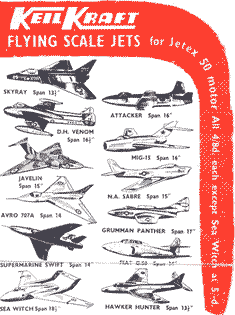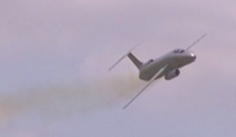|
|
|
|||
|
|
||||
|
|
||||
| The (Jet)X Files | ||||
|
|
HOME | SITE MAP | FORUM | CONTACT |
|
||
|
ABOUT | MOTORS | MODELS | ARCHIVE | HISTORY | STORE | FAQ | LINKS
|
|
|
|
|
|
|||||||||||||||||||||||||||||||||||||||||||||||||||||||||
|
The (Jet)X Files
for December 2002
by Roger Simmonds Reprinted from SAM 35 Speaks, December 2002 (with revisions) It has been some time since there was a column devoted to Jetex power in SAM Speaks. This seems to be a pity, as there has been a renaissance in small "jet" (rocket) powered planes in the last few years, as evidenced by the many different models seen at meetings and the spectator interest they receive. But what has this got to do with SAM 35, you may well ask? Is this vintage modelling? |
|
|||||||||||||||||||||||||||||||||||||||||||||||||||||||||
|
I think it is. First, many of the models are scaled down versions of the old KK and Veron Flying Scale Jetex kits, and the majority of the new designs use traditional modelling techniques, notably those of Bill Dean, and are real stick and tissue jobs. In the main, the models are of fifties types, and seeing them in the air brings back memories of those days and the SBAC shows. So nostalgia is very definitely a part of the scene. A major reason and stimulus for the revival has been the availability of the "one shot" Rapier units, as well as some very nice kits from Aerographics, and the recent contributions of gifted individuals who have published plans and articles in, for example, Model Flyer and Flying Model Designer and Constructor. The Aerographics Bell XS-1 for a Rapier L2 and the KK MiG 15 (still available as a kit, which can be built unchanged for a Rapier L2HP) are particularity suitable for beginners. These and others can give a relatively painless introduction to the genre. For others, the lure is of making something unique, and here the reliability of the Rapier units means that one can concentrate on trimming and flying (and not just getting the fuel burning). Motors within batches are reproducible and small trim changes can be explored with some confidence and an acceptable flight pattern developed. In the main, getting good flights seems to be less difficult with Rapiers than I remember with the old Jetex powered models. |

-
KeilKraft catalogue, c. 1961
|
|||||||||||||||||||||||||||||||||||||||||||||||||||||||||
|
This has been a spur to attempt some unusual and potentially difficult shapes. For example WW2 German "might have beens", Fairey Deltas, tailless types and even multi-engined types such as the Martin XB-51 and an Airbus have flown successfully. For me, getting these models from my youth to fly well has been a real thrill, and searching out new prototypes, with the help of some good websites (in particular those of Mike Stuart and Pete Williams [regrettably, no longer online]), perusing book shops and importuning old flying colleagues for scale drawings has fitted in well with other SAM type activities. But where is Jetex in all this? Are they to be forgotten? I hope not. Rapier units, good as they are, tend to be expensive, and different batches of the same motor may require some retriming of models. More importantly, Rapier units are not as suitable for augmenter tubes. The nozzle shape in particular is perhaps incompatible with this device, and Rapiers do eject much more debris. To bury the motor unit in a model is well nigh impossible (although I have some hopes for some French Ram Jet prototypes, we shall see), and one has to accept the compromise of the motor being all too visible, especially in static display. This always was an acceptable compromise of course, but a sleek shape like the Hunter really deserves better. The great interest in miniature jet flying that the Rapiers have stimulated shows there will be a viable market for a Jetex units when fuel problems have been sorted out. When they are (and I have high hopes) there will be a body of experienced modellers to get the best out of them, and a range of established models to adapt. As I said earlier, the Rapier units have made trimming of these somewhat wayward models easier, and it is now becoming possible to predict what prototypes can be attempted with a little confidence. It may also be possible to lay down ground rules for rigging angles, thrust lines, position of motor, power requirements, etc. to achieve a satisfying flight pattern. This could be a subject for another column, but given the state of current progress, Iím looking forward to seeing a Douglas X-3 cavorting about the sky quite soon! |
 Mike Stuart's Rapier-powered Martin XB-51
- Graham Knight, July, 2002
|
|||||||||||||||||||||||||||||||||||||||||||||||||||||||||
|
|
|
|||||||||||||||||||||||||||||||||||||||||||||||||||||||||
|
|
|
|
|
|
|
|
Acknowledgements - Article contributed by Roger Simmonds - Illustration (KeilKraft catalogue) contributed by Brian Benson |
|
|
|
|
ABOUT | MOTORS | MODELS | ARCHIVE | HISTORY | STORE | FAQ | LINKS |
|
|
Terms of Use
|
Queries? Corrections? Additions?
Please
contact us.
|
|